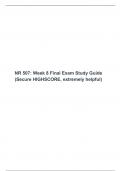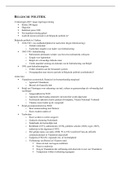-
1. Exam (elaborations) - Nr507 final exam study guide (set-3), nr 507: advanced pathophysiology, chamberlain c...
-
2. Exam (elaborations) - Nr507 final exam study guide (set-2), nr 507: advanced pathophysiology, chamberlain c...
-
3. Exam (elaborations) - Nr 507 final exam (version 6), nr 507: advanced pathophysiology, chamberlain college ...
-
4. Exam (elaborations) - Nr 507 final exam (version 5), nr 507: advanced pathophysiology, chamberlain college ...
-
5. Exam (elaborations) - Nr 507 final exam (version 4), nr 507: advanced pathophysiology, chamberlain college ...
-
6. Exam (elaborations) - Nr 507 final exam (version 3), nr 507: advanced pathophysiology, chamberlain college ...
-
7. Exam (elaborations) - Nr 507 final exam (version 2), nr 507: advanced pathophysiology, chamberlain college ...
-
8. Exam (elaborations) - Nr 507 final exam (version 1), nr 507: advanced pathophysiology, chamberlain college ...
-
9. Exam (elaborations) - Nr 507 week 8 final exam (latest 7 versions), nr 507: advanced pathophysiology, chamb...
-
10. Exam (elaborations) - Nr 507 mid term study guide (set-3)/ nr 507 week 4 midterm study guides, nr 507: adva...
-
11. Exam (elaborations) - Nr 507 mid term study guide (set-2)/ nr 507 week 4 midterm study guides, nr 507: adva...
-
12. Exam (elaborations) - Nr 507 mid term study guide (set-1)/ nr 507 week 4 midterm study guides, nr 507: adva...
-
13. Exam (elaborations) - Nr 507 midterm exam / nr 507 week 4 midterm exam (version-7), nr 507: advanced pathop...
-
14. Exam (elaborations) - Nr 507 midterm exam / nr 507 week 4 midterm exam (version-6), nr 507: advanced pathop...
-
15. Exam (elaborations) - Nr 507 midterm exam / nr 507 week 4 midterm exam (version-5), nr 507: advanced pathop...
-
16. Exam (elaborations) - Nr 507 midterm exam / nr 507 week 4 midterm exam (version-4), nr 507: advanced pathop...
-
17. Exam (elaborations) - Nr 507 midterm exam / nr 507 week 4 midterm exam (version-3), nr 507: advanced pathop...
-
18. Exam (elaborations) - Nr 507 midterm exam / nr 507 week 4 midterm exam (version-2), nr 507: advanced pathop...
-
19. Exam (elaborations) - Nr 507 midterm exam / nr 507 week 4 midterm exam (version-1), nr 507: advanced pathop...
-
20. Exam (elaborations) - Nr 507 final exam (version 7), nr 507: advanced pathophysiology, chamberlain college ...
-
21. Exam (elaborations) - Nr 507 week 1 quiz (version 4), nr 507: advanced pathophysiology, chamberlain college...
-
22. Exam (elaborations) - Nr 507 week 1 quiz (version 3), nr 507: advanced pathophysiology, chamberlain college...
-
23. Exam (elaborations) - Nr 507 week 1 quiz (version 5), nr 507: advanced pathophysiology, chamberlain college...
-
24. Exam (elaborations) - Nr 507 week 1 quiz (version 2), nr 507: advanced pathophysiology, chamberlain college...
-
25. Exam (elaborations) - Nr 507 week 1 quiz (version 1), nr 507: advanced pathophysiology, chamberlain college...
-
26. Exam (elaborations) - Nr 507 week 2 quiz 2 (version 4), nr 507: advanced pathophysiology, chamberlain colle...
-
27. Exam (elaborations) - Nr 507 week 2 quiz 2 (version 3), nr 507: advanced pathophysiology, chamberlain colle...
-
28. Exam (elaborations) - Nr 507 week 2 quiz 2 (version 2), nr 507: advanced pathophysiology, chamberlain colle...
-
29. Exam (elaborations) - Nr 507 week 2 quiz 2 (version 1), nr 507: advanced pathophysiology, chamberlain colle...
-
30. Exam (elaborations) - Nr 507 week 3 quiz 3 (version 5), nr 507: advanced pathophysiology, chamberlain colle...
-
31. Exam (elaborations) - Nr 507 week 3 quiz 3 (version 4), nr 507: advanced pathophysiology, chamberlain colle...
-
32. Exam (elaborations) - Nr 507 week 3 quiz 3 (version 3), nr 507: advanced pathophysiology, chamberlain colle...
-
33. Exam (elaborations) - Nr 507 week 3 quiz 3 (version 2), nr 507: advanced pathophysiology, chamberlain colle...
-
34. Exam (elaborations) - Nr 507 week 3 quiz 3 (version 1), nr 507: advanced pathophysiology, chamberlain colle...
-
35. Exam (elaborations) - Nr 507 week 6 quiz 6 (version 3), nr 507: advanced pathophysiology, chamberlain colle...
-
36. Exam (elaborations) - Nr 507 week 6 quiz 6 (version 2), nr 507: advanced pathophysiology, chamberlain colle...
-
37. Exam (elaborations) - Nr 507 week 6 quiz 6 (version 1), nr 507: advanced pathophysiology, chamberlain colle...
-
38. Exam (elaborations) - Nr 507 week 5 quiz 5 (version 2), nr 507: advanced pathophysiology, chamberlain colle...
-
39. Exam (elaborations) - Nr 507 week 5 quiz 5 (version 1), nr 507: advanced pathophysiology, chamberlain colle...
-
40. Exam (elaborations) - Nr 507 week 7 quiz 7 (version 5), nr 507: advanced pathophysiology, chamberlain colle...
-
41. Exam (elaborations) - Nr 507 week 7 quiz 7 (version 4), nr 507: advanced pathophysiology, chamberlain colle...
-
42. Exam (elaborations) - Nr 507 week 7 quiz 7 (version 3), nr 507: advanced pathophysiology, chamberlain colle...
-
43. Exam (elaborations) - Nr 507 week 7 quiz 7 (version 2), nr 507: advanced pathophysiology, chamberlain colle...
-
44. Exam (elaborations) - Nr 507 week 7 quiz 7 (version 1), nr 507: advanced pathophysiology, chamberlain colle...
-
45. Exam (elaborations) - Nr507 week 6 case study, nr 507: advanced pathophysiology, chamberlain college of nu...
-
46. Exam (elaborations) - Nr 507 week 6 td and quiz, nr 507: advanced pathophysiology, chamberlain college of ...
-
Show more





